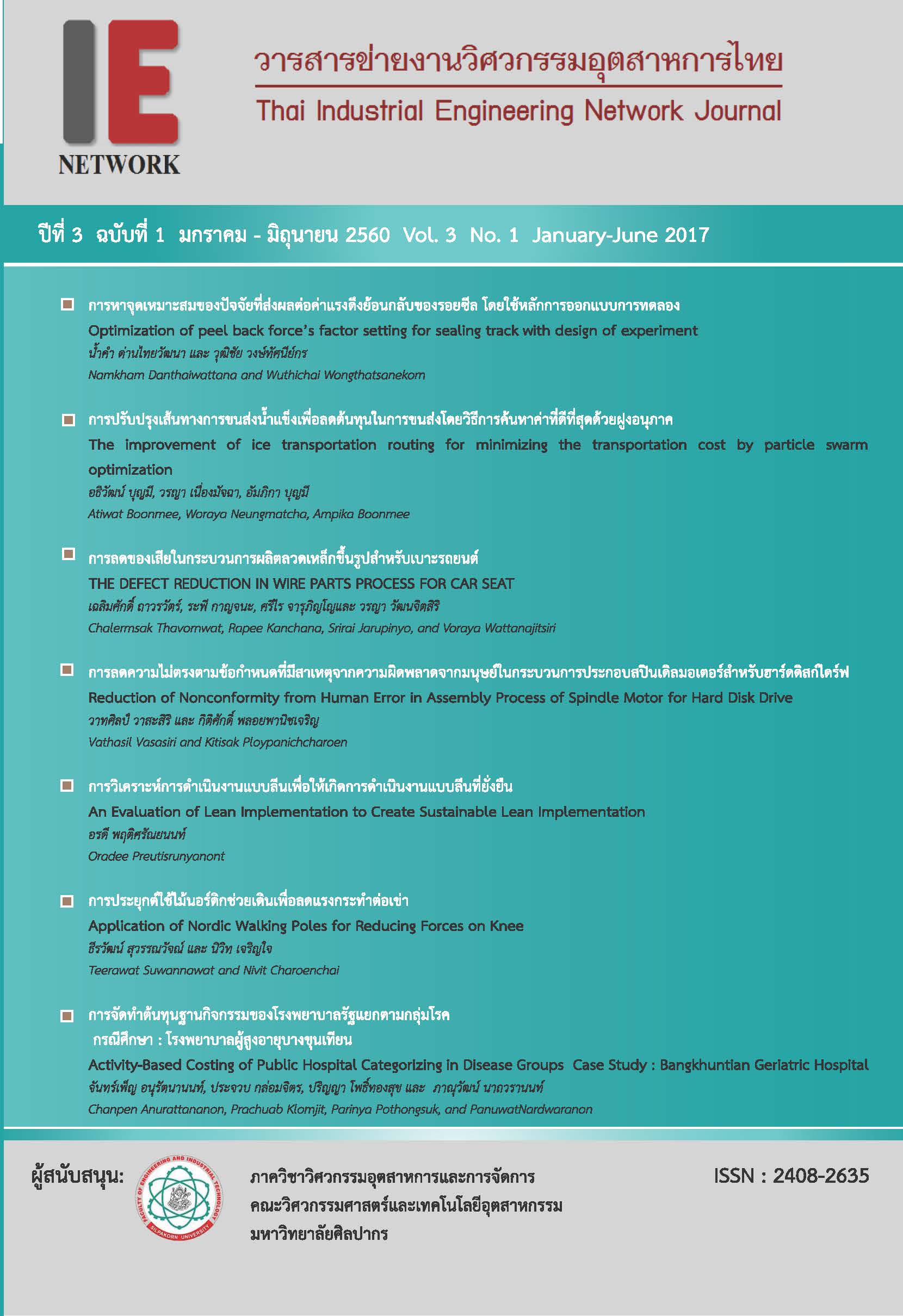โครงสร้างจุลภาคและความแข็งของอะลูมิเนียมพรุนขึ้นรูปด้วยกรรมวิธีโลหะผงโดยใช้เกลือเป็นวัสดุแทนที่รูพรุน
Main Article Content
บทคัดย่อ
อะลูมิเนียมพรุนถูกสร้างขึ้นด้วยกรรมวิธีขึ้นรูปโลหะผงโดยใช้เกลือเป็นสารสร้างรูพรุน ในการผลิตอะลูมิเนียมพรุนผงเกลือถูกผสมลงในผงอะลูมิเนียมในปริมาณ 10 – 60 เปอร์เซ็นต์โดยน้ำหนัก จากนั้นนำผงอะลูมิเนียมผสมไปอัดขึ้นรูปที่ความดันคงที่ 400 เมกะปาสคาลและเผาหลอมรวมที่อุณหภูมิ 650 องศาเซลเซียส 1 ชั่วโมง โครงสร้างทางจุลภาคและความแข็งของอะลูมิเนียมพรุนจะทำการวิเคราะห์ด้วยกล้องจุลทรรศน์อิเล็กตรอนแบบส่องกราดและเครื่องทดสอบความแข็งตามลำดับ ผลการทดลองพบว่าปริมาณของเกลือส่งผลต่อวิวัฒนาการของโครงสร้างจุลภาคและความแข็งของอะลูมิเนียมพรุนเป็นอย่างมาก ปริมาณรูพรุนเพิ่มขึ้นเมื่อเพิ่มปริมาณเกลือ ในขณะที่ความแข็งลดลงเมื่อปริมาณเกลือเพิ่มขึ้น รูพรุนที่เกิดขึ้นมีรูปร่างคล้ายกับรูปร่างของเกลือและมีการกระจายตัวที่ค่อนข้างสม่ำเสมอ ในการศึกษาครั้งนี้สามารถผลิตอะลูมิเนียมพรุนที่มีความพรุนสูงถึง 61.54 %
Article Details
บทความ ข้อมูล เนื้อหา รูปภาพ ฯลฯ ที่ได้รับการตีพิมพ์ในวารสารฯ ถือเป็นลิขสิทธิ์ของวารสารฯ หากบุคคลหรือหน่วยงานใดต้องการนำทั้งหมดหรือส่วนหนึ่งส่วนใดไปเผยแพร่ต่อหรือเพื่อกระทำการใดๆ จะได้รับอนุญาต แต่ห้ามนำไปใช้เพื่่อประโยชน์ทางธุรกิจ และห้ามดัดแปลง
References
[2] มนัส สถิรจินดา, โลหะนอกกลุ่มเหล็ก, กรุงเทพมหานคร: สานักพิมพ์แห่งจุฬาลงกรณ์มหาวิทยาลัย, 2541
[3] สถาบันเหล็กและเหล็กกล้าแห่งประเทศไทย, การสำรวจสถานภาพอุตสาหกรรมโลหะนอกกลุ่มเหล็ก (Non-
ferrous metals): อะลูมิเนียม ภายใต้โครงการพัฒนาศูนย์ข้อมูลเชิงลึกอุตสาหกรรมเหล็กและโลหการประจาปี
งบประมาณ 2557, 2557.
[4] Mccullough K.Y.G., Fleck N.A. and Ashby M.F. (1999) Uniaxial stress-strain behavior of aluminum alloy foams, Acta mater, Vol. 47, p. 2323±2330.
[5] Bin J., Zejun W. and Naiqin Z. (2007) Effect of pore size and relative density on the mechanical properties of open cell aluminum foams, Scripta Materialia, Vol. 56, p. 169–172
[6] Campus J.M. (2000), Met. Powder: A Global survey of production, All. And markets, Metal Powder Industries Federation
[7] Srivastava V.C. and Sahoo K.L. (2007) Processing, stabilization and applications of metallic foams, Materials Science-Poland, p. 733–753
[8] Hasan B. and Ali H. (2010) Production of aluminum foam by spherical carbamide space holder technique-processing parameters, Materials and Design, p.4122–4129
[9] Liu X.J., Huai Z., Lu Y., C.P. (2012) Wang, Microstructure and mechanical behavior of Ni–Cu–Fe–Si porous alloys, Materials Science and Engineering: A 545, P. 111–117
[10] Hussain Z. and Suffin N. S. A., (2011) Microstructure and Mechanical Behaviour of Aluminium Foam Produced by Sintering Dissolution Process Using NaCl Space Holder, Journal of Engineering Science, P. 37–49
[11] Torres Y., Pavón J.J., Rodríguez J.A. (2011) Processing and characterization of Porous titanium for implants by using NaCl as Space holder, Journal of Materials Processing Technology , P. 1061–1069
[12] Michailidis, N. & Stergioudi, F., (2011) Establishment of process parameters for producing Al-foam by dissolution and powder sintering method. Mater. Des., 32(3), p. 1559–1564
[13] Bafti, H. & Habibolahzadeh, A. (2010). Production of aluminum foam by spherical carbamide space holder technique-processing parameters. Mater. Des., p. 4122–4129

